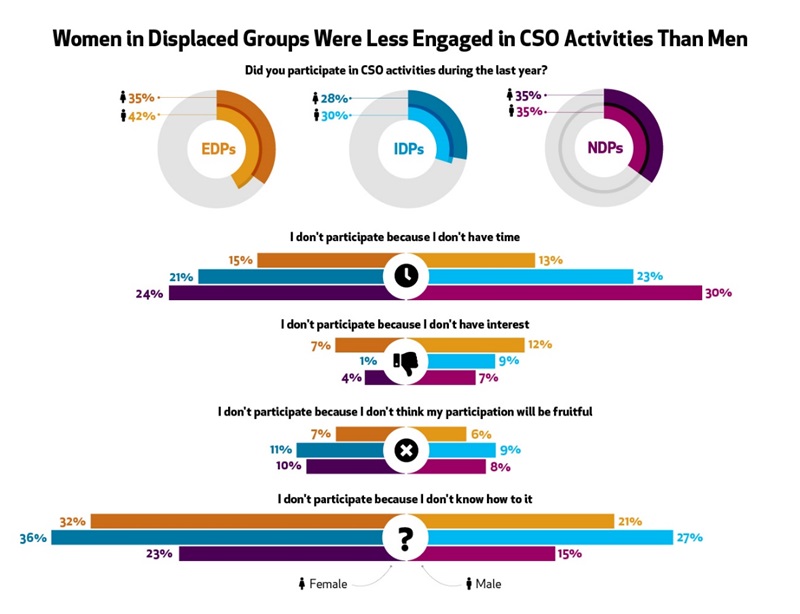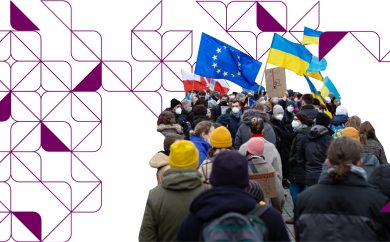USAID/ENGAGE presents key findings of gender-based disaggregation analysis of the spring-summer 2023 Civic Engagement Poll (CEP). To better understand gender-based differences of Ukrainians’ civic engagement, democratic participation, awareness of reforms, civic knowledge and perception of pot-war priorities, we have disaggregated CEP data by biological sex in three groups of adult respondents: non-displaced Ukrainians (NDPs), Ukrainians who were externally displaced abroad due to the war (EDPs) and internally displaced persons (IDPs).
Displaced Women Demonstrate Lower Levels of Engagement and Lack Knowledge on Available Avenues to Join CSO-led and Community Initiatives
Internally and externally displaced women are less actively engaged in the life of their communities compared to displaced men and non-displaced women. For example, within the group of non-displaced respondents (NDPs),55% of women reported attending meetings or joining community initiatives in their communities, compared to 51% of men. In contrast, 35% of internally displaced and 25% of externally displaced women were active community members, compared to 37% and 32% of men respectively. Furthermore, these differences can be understood through the lens of the significant role that family care responsibilities play in the lives of displaced women. As recent research shows, despite the change of gender norms resulting from women’s involvement in war-related activities, conservative gender norms persist in Ukraine – women are seen as “guardians of the home hearth”. Moreover, ENGAGE data shows that “care for the family” is seen as key barrier to a more active participation among women.
A similar trend is observed when it comes to participation in CSO activities. While women from the NDP group participated in CSO activities as actively as men (both at 35%), women in both displaced groups were less engaged than men: 35% of women versus 42% of men in the EDPs sample; and 28% of women versus 30% of men in the IDPs group of respondents.
In addition, a significant barrier to women’s participation in both community life and CSOs was unfamiliarity with engagement avenues. For instance, among non-displaced women, 14% cited this as a major obstacle, with the figure rising to 28% and 27% for externally and internally displaced women, respectively. Conversely, this obstacle to participation was less pertinent for male respondents, with 10% of NDP men, 22% of EDP men, and 22% of IDP men noting lack of awareness of how to engage as a barrier. Lack of knowledge of possible avenues to join CSO activities was the primary reason for non-participation of 23% of NDP women, 32% of externally displaced women, and 36% of internally displaced women. This obstacle to participation in CSO work was reported by a smaller share of male respondents in each of the three surveyed groups: 15% of NDPs, 21% of EDPs, and 27% of IDPs.
However,at the same time, women are more interested in joining CSO activities than men. Among NDPs, 7% of men indicated a lack of interest as their reason for non-participation, while 4% of women from this group expressed the same sentiment. Similarly, within internally displaced group, 9% among men and 1% among women reported they didn’t participate because they did not have interest, while among EDPs the same reason prevailed for 12% men and 7% of women respectively.
Physical Health and Age are Women-Specific Barriers to Participation
While a lack of free time is a traditional barrier for both genders, the state of physical health stands out as a notable obstacle, particularly among women residing in Ukraine who experience inconsistent access to health services and other health-related risks in war-affected areas. To illustrate, among non-displaced women, 23% cited physical health condition as a significant obstacle to engaging in civic activities, in contrast to 15% of men in the same group. Similarly, within the internally displaced population, 22% of women identified their physical health as a barrier, compared to 12% of IDP men. Furthermore,15% of NDP women also mentioned age as an impediment to civic engagement. This may be an indication that most of women who did not change their place of residence are of older age and are less mobile. This finding may suggest a possible correlation between age and mobility, implying that a considerable portion of women who did not change their place of residence may belong to an older age demographic, potentially leading to reduced mobility and, consequently, lower civic engagement levels.
With Few Exceptions, Men Demonstrate Higher Level of Democratic Participation
CEP data reveals noticeable gender disparities in democratic participation levels, with men generally displaying higher levels of engagement. However, there are noteworthy exceptions. For example, when it comes to starting or signing of electronic petitions, women from NDP and EDP groups are slightly more active than men (29% vs. 27% and 41% vs 35% respectively). Displaced women also report more active participation in peaceful assemblies: 27% of EDP women compared to 25% of EDP men, and 16% of IDP women compared to 7% of IDP men. NDP women take the lead in reporting on damaged infrastructure to local authorities, with 18% compared to 15% of men.
Despite the gender disparities in other areas, donating money to support resistance against Russia’s aggression emerges as a popular avenue for civic activism among women in all three groups. An impressive 70% of externally displaced women and 67% of women in both NDP and IDP groups have made donations for this cause. In contrast, 75% of men from EDP and NDP groups, as well as 67% of internally displaced men, have done the same.
Importantly, in all three groups women were significantly less active than men in terms of reporting corruption. Among non-displaced and externally displaced women, only 2% reported corruption to law enforcement agencies. In contrast, for men in these respective groups, the figure was notably higher at 4% and 5%. Among internally displaced women, the percentage reporting corruption was slightly higher at 3%, but still considerably lower than the 5% reported by internally displaced men. Additionally, when considering the realm of digital spaces, women’s participation is similarly limited when it comes to reporting corruption online. Only 3% of non-displaced women and 2% of women from both internally and externally displaced groups engaged in online reporting of corruption. In contrast, the participation rate among men was higher, with 3% of non-displaced men, 7% of internally displaced men, and 8% of externally displaced men reporting corruption through online channels.
Men and Women Exhibit Divergent Views Regarding Future Personal Priorities
CEP revealed that while both men and women from all three groups consider employment a matter of personal priority to be resolved after the war, there are notable gender disparities in identifying future priorities. Among non-displaced respondents, men tend to prioritize their income slightly more than women (20% of men compared to 18% of women). Conversely, NDP women are more focused on the state of their physical health, with 15% considering it a major concern compared to 12% of men in the same group. Reconstruction of destroyed cities and houses is a top priority for IDPs (30% of women vs 26% of men).
Building on this, only externally displaced men (24%) identified corruption as a top personal issue to be resolved after the war. EDP women tend to prioritize issues related to education (20%) and housing (20%).
Despite Consensus on Post-War Priorities, Men Prioritize Corruption as Top National Concern
While individual priorities varied, there was more consensus when respondents considered the broader national challenges post-war. Those include restoration of infrastructure, corruption and economic recovery. Women in all three groups prioritize restoration of infrastructure more than men. For example, 52% of NDP women vs 42% of men; 56% of IDP women vs 39% of men; and 41% EDP women vs 23% of men. Corruption stands out as a “men’s issue,” particularly when it comes to the displaced populations. Specifically, 37% of NDP men, 34% of IDP men and 41% of EDP men, naming it a major priority for post-war Ukraine. In contrast, a smaller proportion of women share this belief, with 39% of externally displaced women, 28% of non-displaced women, and 27% of EDP women considering corruption a major issue for the country. Given the economic challenges post-war, among displaced populations, both men and women express significant concern about economic recovery. Particularly in the externally displaced (EDP) group, an equal share of 24% of both men and women consider economic recovery a top priority for the country. Similarly, in the internally displaced (IDP) group, 30% of men and 27% of women share this viewpoint, emphasizing the importance of economic stability for displaced individuals. However, a contrasting view emerges among the non-displaced population.. While 23% of non-displaced women see economic recovery as a major issue of national importance, men in this group prioritize ensuring security (19%) over economic concerns.
On the issue of civil society, across all three groups, women express less inclination to donate money to civil society organizations (CSOs) that focus on holding the government accountable, promoting reforms, and EU integration. This trend is particularly evident in the EDP and NDP groups, where fewer women are ready to financially support advocacy-focused CSOs compared to men. To illustrate, in the EDP group, 41% of women are ready to financially support advocacy-focused CSOs compared to 52% of men. Likewise, in the NDP group, 46% of women are ready to support such CSOs compared to 57% of men. Yet, in the IDP group, an almost equal share of women (49%) and men (50%) express the intention to donate money to CSOs.
Women Demonstrate Higher Awareness of Reforms, While Men Show Stronger Civic Knowledge
In terms of awareness levels, women across all three groups exhibit higher levels of awareness regarding government reforms compared to men. Among non-displaced individuals, for instance,55% of women report being aware of government reforms, overshadowing the 44% of men in this group. In the context of EDPs, the gap in reform awareness is even more pronounced, with 55% of women informed about government reforms, while a lesser 43% of men in this group share this . In contrast, when examining civic knowledge among internally displaced individuals (IDPs), women continue to outpace men in reform awareness, with 51% of women being aware of government reforms compared to 39% of men in this group.
Interestingly, despite the disparities in reform awareness, when it comes to broader understanding of civic duties, men exhibit a slight edge. As part of the survey, respondents were asked civic knowledge questions on the fundamentals of state functioning, human rights, and financial literacy. Across the board, men outperformed their female counterparts. However, there were exceptions to this trend. In terms of defining fundamental rights and freedoms of citizens, women seemed to have the upper hand. To put in perspective, in the non-displaced (NDP) group, 48% of women demonstrated accurate knowledge, slightly overshadowing the 46% of men. Similarly, among the externally displaced (EDP) group, women shone brighter with 63% of women providing correct answers a notable difference from the 51% of men. In a parallel trend, within the internally displaced (IDP) group, 52% of women showcased a commendable grasp of the subject, compared to 40% of men.
This survey summary was prepared by Pact as part of the USAID/ENGAGE activity, which is funded by the United States Agency for International Development (USAID). The contents of this survey summary are the sole responsibility of Pact and do not necessarily reflect the views of USAID or the United States Government.
About the CEP
The Civic Engagement Poll (CEP) is conducted under the framework of the Enhance Non-Governmental Actors and Grassroots Engagement activity (USAID/ENGAGE), implemented by Pact. This report summarizes key takeaways from the poll, drawing from survey data collected in the spring-summer of 2023 by the research agency, Info Sapiens.
Under USAID/ENGAGE, CEP has been conducted since 2018 and gauges citizen awareness of and engagement in civil society activities, as well as citizens’ participation in and perception of reform processes in Ukraine. During the most recent survey, respondents were also asked questions about their involvement in resisting Russia’s aggression and priorities for post-war reconstruction. In this installment of the CEP, data was collected in two samples among Ukrainians residing in Ukraine and those who have moved abroad due to the war (EDPs). Ukrainians residing in Ukraine were disaggregated from those who have moved to another city/oblast after February 24, 2022, due to the war (IDPs) and those who did not (NDPs).
To collect the data for the Ukrainians residing in Ukraine, sample telephone interviews were conducted with Ukrainian citizens aged 18 years and older. The survey sampled 2,017 respondents and was designed in accordance with the distribution of the adult population of Ukraine by age, sex, oblast, and settlement type according to the data of the State Statistics Service of Ukraine as of January 1, 2019 (excluding Crimea and non-government-controlled areas of the Donetsk and Luhansk Oblasts). The margin of error of the sample is 2.2% (excluding the design effect). For analysis purposes, 248 IDPs and 1,769 NDPs were disaggregated from this sample based on the displacement within the country as a result of the war.
During the data collection stage, the survey was also conducted with citizens from Ukraine aged 18 years old and older seeking temporary protection (EDPs) in Poland, Germany, Czech Republic, and Italy. The survey sampled 1,002 respondents. For this sample, online interviews were conducted with links to the online questionnaire sent by SMS to potential respondents randomly. The sample design corresponds to the distribution of refugees by country, according to the data provided by UNHCR. The margin of error does not exceed 3.1%.






